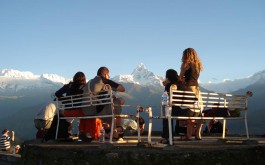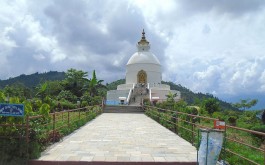Pokhara

Pokhara, one of the most popular places in the tourism industry, promises a lot and it would simply freshes your journey every time you visit there. Having the natural potentiality this place also offers you the cultural visit. As it is the transitional point for the western Nepal, commerce and trade, most of the trekking routes starts here; commonly, people call it as the place of lakes or Tal; as numerous lakes exist. You make either cultural sightseeing or natural one, both ways good dealing comes forth.
Fewa Lake -
Fewa Lake is the most beautiful and second biggest take in Nepal. Its average depth is 8.6m and maximum depth is 19m. Its covers an average area of 4.4 sq. km. On its southwest side there is a protected dense forest and on the Northeast side there is a beautiful built-up area. “The Lake Side” the main tourist center of Pokhara. In the middle of the lake there is an island where a famous Barahi Temple is located. Fewa Lake is famous for its flat water boating. Engine boats are not allowed in the lake.
Barahi Temple -
Located in the middle of the lake, Barahi temple (Pagoda style) is a famous pilgrimage site. Everyday hundreds of visitors visit the temple. Different types of trees and flowers cover the small island. It takes less than 10 minutes by boat to reach the island. It is an ideal place in Pokhara to enjoy the lake, Himalaya views and the lakeside built up area at the same time.
Devi’s Fall -
Devi’s Fall is one of the popular tourist sites in Pokhara. It is also popularly known as Patale Chhango (underground water fall). Devi’s Fall is named after the name of Swiss women Ms. Devi. One day in 1961, Ms Devi was swimming near the waterfall of Fewa Dam with her husband and at the same time the dam overflowed suddenly and swept away her into a deep gorge to death in 1961. Since then the waterfall is named as Devi’s Fall. It is and awesome waterfall just 2km south of the Pokhara airport. City buses and taxis are available to go to the waterfall.
Gupteswor Cave -
Opposite of the Devi’s fall, there is a beautiful cave. The whole area of the cave is very big and needs well preparation to explore it. The cave also a popular pilgrimage site. There is a natural image of Lord Shiva, which was naturally found beneath the earth. Many devotees visit the cave everyday. Well-maintained steps are constructed with sufficient lights to enter into the cave. There is a small tunnel behind the Shiva image that links the cave to the Devi’s fall. It takes about 10 minutes to reach Devi’s fall through the tunnel. It is an exciting part of the cave that adventure visitors have also the opportunity to enjoy the underground view of Devi’s Fall. Since the tunnel is a kind of adventurous aspect that one should take care while being in the tunnel.
Mahendra Cave -
Mahendra Cave is another natural wonder in Pokhara is the Mahendra Cave. The cave has not been fully explored yet. It is advised that visitors should have a torch or a guide to enter into the cave. The cave management committee also provides guide an torch if requested. Mahendra Cave is named after the late King Mahendra and is situated some 9 km. North of Pokhara Airport. City buses and taxis are regularly available to go to the cave. There is another cave nearby Mahendra Cave known as the Bat’s Cave or Chamere Gupha.
Bindabasini Temple -
It is an wonderful and the most popular pilgrimage site located on a small beautiful hillok some 4 km. North of airport. Bindabasini is regarded as Shakti Pitha of goddess Bhagabati. The temple area is like a park and is ideal for sightseeing. There are also few more temples including one Shiva temple nearby Bindabasini Temple.
Bhadrakali Temple -
Situated in the middle of a beautiful forest on the top of a small hillock, Bhadrakali Temple is one of the attractive sightseeing spots in Pokhara. The location is superb for mountain view and Pokhara city view. situated some 4 km. east of airport at Matepani, Bhadrakali is a peaceful area. it is also a right place for birds and butterflies watching. A park is being developed around the temple.
Tibetan Refugee Camp -
There are three Tibetan refugee camps. One is 2km. South from the airport near the Devi’s fall at Chhorepatan, the second is in Prithwichowk and the third is 7km. North of airport in Hemja. All the camps are worth visiting to know Tibetan culture, their tradition and living style. Within the camps there are handicraft centers.
Buddhist Monastery -
It is also called Nyeshang Monastery established in 1960 by Manangi Buddhists. This monastery is situated at Matepani about 4km east of the airport. It is built on a small hillock and one can enjoy nice view of Pokhara city as well as the mountain ranges.
Seti River -
It is another mysterious natural wonder of Pokhara. Originated from the Machhapuchre glacier, Seti river runs through the main city area. The river provides a perfect view of its dreadful rush before it goes underground or disappears at Bagar into a deep gorge. The gorge is narrow but very deep that in some place it goes down to more than 60 meters deep. KI Sing Bridge, Mahendrapool and Prithvichowk are the main places to observe the underground river and its roaring sound.The surprising aspect of the river that even during the rainy season the swelling floodwater does not block into the narrow gorge.
Begnas and Rupa Lakes
Begnas lake lies 17km east of Pokhara airport. Like Fewa lake, Begnas lake is also perfect for boating. It reflects the beautiful image of Annapurna IV. Rupa lake is situated at the east of Beganas lake. A small hillock has separated the two lakes. Both lakes are famous for boating and fishing. There are buses running from city center of Pokhara to Beganas and Rupa lakes
International Mountain Museum
Nepal is predominantly a Mountainous country in the world. It congregates more than 1310 peaks of above 6000m including the highest summit of the earth, The Mount Everest (8848m). Nepal is, therefore also known as the playground of mountaineers in the world. The International Mountain Museum provides the detail information about mountaineering activities in Nepal as well as the mountaineering profiles and history of all the mountaineers who came to Nepal for mountaineering. The collections in the museum are equipments, climbing gears, clothes and other items used by the mountaineers during their expedition period.



